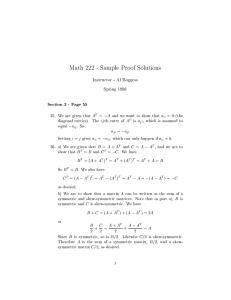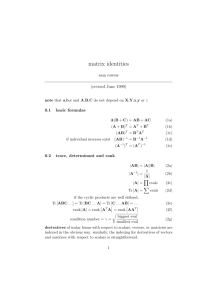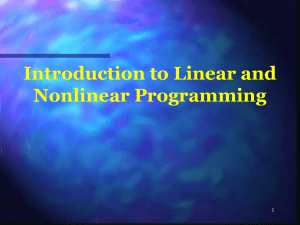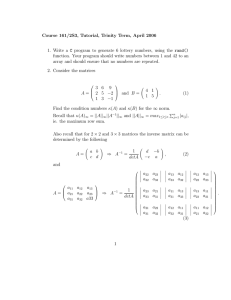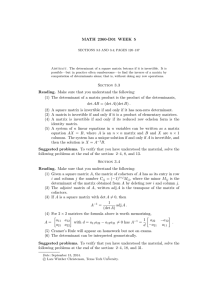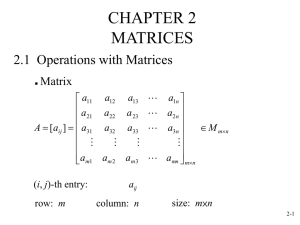Document 10551429
advertisement
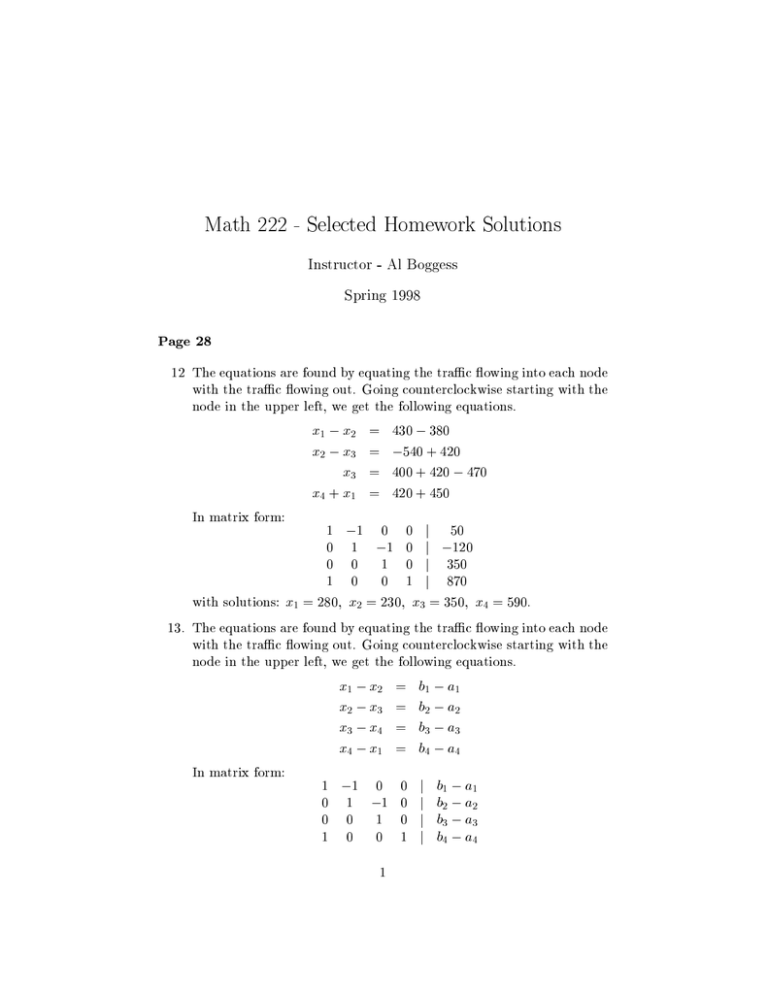
Math 222 - Selected Homework Solutions Instructor - Al Boggess Spring 1998 Page 28 12 The equations are found by equating the trac owing into each node with the trac owing out. Going counterclockwise starting with the node in the upper left, we get the following equations. x1 , x2 = 430 , 380 x2 , x3 = ,540 + 420 x3 = 400 + 420 , 470 x4 + x1 = 420 + 450 In matrix form: 1 ,1 0 0 j 50 0 1 ,1 0 j ,120 0 0 1 0 j 350 1 0 0 1 j 870 with solutions: x1 = 280; x2 = 230; x3 = 350; x4 = 590. 13. The equations are found by equating the trac owing into each node with the trac owing out. Going counterclockwise starting with the node in the upper left, we get the following equations. x1 , x2 = b1 , a1 x2 , x3 = b2 , a2 x3 , x4 = b3 , a3 x4 , x1 = b4 , a4 In matrix form: 1 ,1 0 0 j b1 , a1 0 1 ,1 0 j b2 , a2 0 0 1 0 j b3 , a3 1 0 0 1 j b4 , a4 1 Using Gaussian elimination, this matrix is equivalent to: 1 ,1 0 0 j b1 , a1 0 1 ,1 0 j b2 , a2 0 0 1 0 j b3 , a3 0 0 0 0 j (b1 + b2 + b3 b4 ) , (a1 + a2 + a3 + a4 ) These equations are consistent if and only if the last entry on the right side is zero, which in turn is equivalent to b1 + b2 + b3 b4) = (a1 + a2 + a3 + a4) 19 a) Using Kircho's Law, i2 = i3 + i1 The other two equations are obtained by using Ohm's law around the two loops of the circuit (voltage = resistance current). The top loop gives: 2i2 + 2i1 = 16 The bottom loop gives: 2i2 + 3i3 = 0 In matrix form: 1 ,1 1 j 0 2 2 0 j 16 0 2 3 j 0 The solution is: x1 = 5; x2 = 3; x3 = ,2. Section 3 - Page 55 15. We are to show that the matrix ! 1 a , a 22 12 M= where d = a a , a a d ,a21 a11 11 22 equals A,1 . To do this, we must show MA = I . We write out MA as ! ! 1 a22 ,a12 a11 a12 a11 a22 , a12 a21 = a a ,1 a a 11 22 12 21 as desired. 12 21 ,a21 a11 a21 a22 ! ! a11 a22 , a12a21 0 1 0 0 a11 a22 , a12 a21 = 0 1 2 16. We are given that A is nonsingular and so A,1 exists and AA,1 = I = A,1 A. To show that A,1 is nonsingular and that (A,1 ),1 = A, we must show that (A,1 )A = I . However, this last equation holds by the denition of A,1 . 17. We are given that A is nonsingular and so A,1 exists and AA,1 = I = A,1A. We must show that AT is nonsingular and that (AT ),1 = (A,1 )T This last equation is equivalent to showing (AT )(A,1 )T = I Using the hint: (AB )T = B T AT with B = A,1 , we obtain (AT )(A,1 )T = (A,1 A)T This in turn, equals I T , which is just I , as desired. 23b) To show that AT A is symmetric, we must show (AT A)T = AT A. Now using the equation (BA)T = AT B T with B = AT , we obtain (AT A)T = AT (AT )T = AT A since (AT )T = A. 24 We are given that A and B are symmetric matrices, which means that AT = A and B T = B . We must show that AB = BA if and only if AB symmetric. We must show both AB = BA => (AB )T = AB and the reverse implication (AB )T = AB => AB = BA. For the rst implication, we assume AB = BA and we must show (AB )T = AB . We have (AB )T = B T AT = BA since B T = B and AT = A. Since BA = AB (by assumption), we have shown (AB )T = AB , as desired. For the second implication, we assume (AB )T = AB and we must show AB = BA. The assumption can be restated as B T AT = AB Since B T = B and AT = A, this equation can be restated as BA = AB which is what we wanted to show. 3 25. We are given that AT = ,A and we want to show that aii = 0 (the diagonal entries). The ij th entry of AT is aji, which is assumed to equal ,aij . So aji = ,aji Setting i = j gives aii = ,aii , which can only happen if aii = 0. 26. a) We are given that B = A + AT and C = A , AT , and we are to show that B T = B and C T = ,C . We have B T = (A + AT )T = AT + (AT )T = AT + A = B So B T = B . We also have C T = (A , AT )T = AT , (AT )T = AT , A = ,(A , AT ) = ,C as desired. b) We are to show that a matrix A can be written as the sum of a symmetric and skew-symmetric matrices. Note that in part a), B is symmetric and C is skew-symmetric. We have B + C = (A + AT ) + (A , AT ) = 2A or B + C = A + AT + A , AT = A 2 2 2 2 Since B is symmetric, so is B=2. Likewise C=2 is skew-symmetric. Therefore A is the sum of a symmetric matrix, B=2, and a skewsymmetric matrix C=2, as desired. 4


